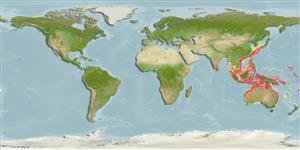Environment: milieu / climate zone / depth range / distribution range
Ökologie
seewasser demersal; tiefenbereich 50 - 150 m (Ref. 90102). Tropical
Indo-West Pacific: Nicobar Islands and throughout most of the Indo-Australian Archipelago, north to southern Japan (Ref. 9774).
Size / Gewicht / Alter
Maturity: Lm ? range ? - ? cm
Max length : 40.0 cm SL Männchen/unbestimmt; (Ref. 9774); common length : 25.0 cm SL Männchen/unbestimmt; (Ref. 9774)
Rückenflossenstacheln (insgesamt) : 0; Rückenflossenweichstrahlen (insgesamt) : 72 - 78; Afterflossenstacheln: 0; Afterflossenweichstrahlen: 56 - 63; Wirbelzahl: 36. Above and below lateral line with 1 or 2 pairs of distinct double ocelli. Many darker rings and spots scattered on body and median fins. Body ovoid, its depth 2.2 to 2.4 times in SL. Head length 3.4 to 3.7 times in SL. Upper profile of head strongly notched in front of upper eye. A line connecting base of first dorsal-fin ray and posterior nostril on eyed side crosses maxilla. Snout protruded, its length 1 to 1.3 times of eye diameter. Eye diameter 4.3 to 5 times in head length. Maxilla extending to below or beyond middle of lower eye. Teeth in both jaws small, without strong canines (Ref 9774). Gill rakers palmate, as broad as long. Two to four large double ocelli on body (Ref. 559).
Inhabits muddy and sandy bottoms of the continental shelves. Feeds on fish (Ref. 30463, 48637) and small benthic animals. Marketed fresh (Ref. 9774).
Life cycle and mating behavior
Geschlechtsreife | Fortpflanzung | Ablaichen | Eier | Fecundity | Larven
Distinct pairing (Ref. 205).
Masuda, H., K. Amaoka, C. Araga, T. Uyeno and T. Yoshino, 1984. The fishes of the Japanese Archipelago. Vol. 1. Tokai University Press, Tokyo, Japan. 437 p. (text). (Ref. 559)
IUCN Rote Liste Status (Ref. 130435: Version 2024-2)
Bedrohung für Menschen
Harmless
Nutzung durch Menschen
Fischereien: kommerziell
Tools
Zusatzinformationen
Download XML
Internet Quellen
Estimates based on models
Preferred temperature (Ref.
123201): 20.5 - 28, mean 25.7 °C (based on 405 cells).
Phylogenetic diversity index (Ref.
82804): PD
50 = 0.5000 [Uniqueness, from 0.5 = low to 2.0 = high].
Bayesian length-weight: a=0.00724 (0.00338 - 0.01553), b=3.17 (3.00 - 3.34), in cm total length, based on LWR estimates for this Genus-body shape (Ref.
93245).
Trophic level (Ref.
69278): 4.2 ±0.73 se; based on food items.
Widerstandsfähigkeit (Ref.
120179): mittel, Verdopplung der Population dauert 1,4 - 4,4 Jahre. (Preliminary K or Fecundity.).
Fishing Vulnerability (Ref.
59153): Moderate vulnerability (39 of 100).
